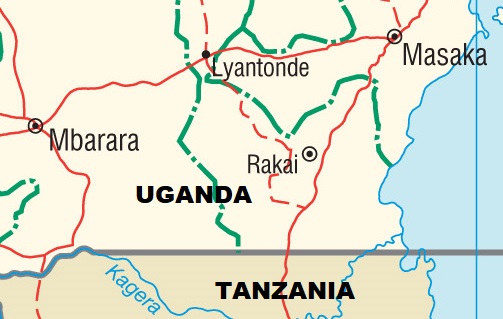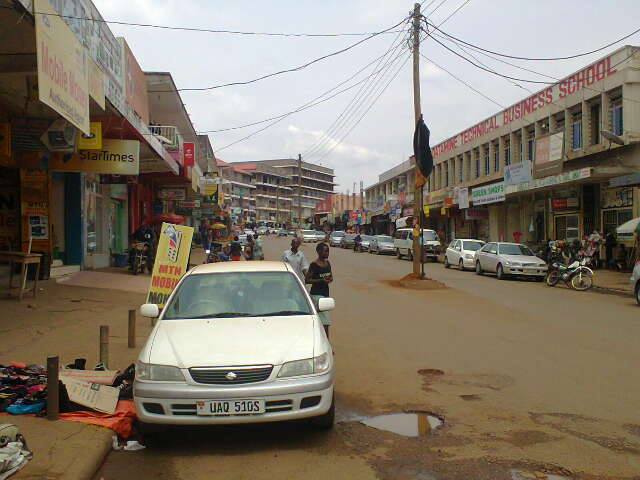|
Battle Of Gayaza Hills
The Battle of Gayaza Hills or the Battle of Kajurungusi (Kiswahili: ''Mapigano ya Kajurungusi'') was a conflict of the Uganda–Tanzania War that took place in late February 1979 around the Gayaza Hills and Lake Nakivale in southern Uganda, near the town of Gayaza. Tanzanian troops attacked the Ugandan positions in the hills, and though they suffered heavy casualties in an ambush, they successfully captured the area by the end of the day. Colonel Idi Amin had seized power in a military coup in Uganda in 1971 and established a repressive dictatorship. Seven years later he attempted to invade Tanzania to the south. Ugandan troops occupied the Kagera Region, Kagera Salient and subsequently murdered local civilians and destroyed property. The attack was eventually repulsed, and Tanzanian President Julius Nyerere, unsatisfied with Amin's refusal to renounce his claims to Tanzanian territory and the international community's failure to strongly condemn the invasion, ordered his forces ... [...More Info...] [...Related Items...] OR: [Wikipedia] [Google] [Baidu] |
Uganda–Tanzania War
The Uganda–Tanzania War, known in Tanzania as the Kagera War (Kiswahili: ''Vita vya Kagera'') and in Uganda as the 1979 Liberation War, was fought between Uganda and Tanzania from October 1978 until June 1979 and led to the overthrow of Ugandan President Idi Amin. The war was preceded by a deterioration of relations between Uganda and Tanzania following Amin's 1971 overthrow of President Milton Obote, who was close to the President of Tanzania, Julius Nyerere. Over the following years, Amin's regime was destabilised by violent purges, economic problems, and dissatisfaction in the Uganda Army. The circumstances surrounding the outbreak of the war are not clear, and differing accounts of the events exist. In October 1978, Ugandan forces began making incursions into Tanzania. Later that month, the Uganda Army launched an invasion, looting property and killing civilians. Ugandan official media declared the annexation of the Kagera Salient. On 2 November, Nyerere declared war on U ... [...More Info...] [...Related Items...] OR: [Wikipedia] [Google] [Baidu] |
Tanzania People's Defence Force
The Tanzania People’s Defence Force (TPDF) ( sw, Jeshi la Ulinzi la Wananchi wa Tanzania) is the military force of the United Republic of Tanzania. It was established in September 1964, following a mutiny by the former colonial military force, the Tanganyika Rifles. From its inception, it was ingrained in the troops of the new TPDF that they were a people's force under civilian control. Unlike some of its neighboring countries, Tanzania has never suffered a coup d'état or civil war. The TPDF's mission is to defend Tanzania and every Tanzanian, especially the people and their political ideology. Conscripts are obligated to serve 2 years as of 2004. History After an aborted mutiny in January 1964, the existing army was disbanded. The new force was titled the 'Tanganyika Military Force', from 25 January 1964 - 26 April 1964. The Tanzanian government concluded that the former British model was not appropriate for the needs of an independent African state. Fresh recruits were so ... [...More Info...] [...Related Items...] OR: [Wikipedia] [Google] [Baidu] |
Fall Of Kampala
The Fall of Kampala, also known as the Liberation of Kampala (Kiswahili: ''Kukombolewa kwa Kampala''), was a battle during the Uganda–Tanzania War in 1979, in which the combined forces of Tanzania and the Uganda National Liberation Front (UNLF) attacked and captured the Ugandan capital, Kampala. As a result, Ugandan President Idi Amin was deposed, his forces were scattered, and a UNLF government was installed. Amin had seized power in Uganda in 1971 and established a brutal dictatorship. Seven years later he attempted to invade Tanzania to the south. Tanzania repulsed the assault and launched a counter-attack into Ugandan territory. After routing the Ugandans and their Libyan allies in Entebbe, the Tanzanians revised their existing offensive designs for Kampala. The plans called for the 208th Brigade to advance from the south, spearheaded by Lieutenant Colonel Ben Msuya's 800-strong 19th Battalion, which was to secure the centre of the city. The 207th Brigade and a UNLF batta ... [...More Info...] [...Related Items...] OR: [Wikipedia] [Google] [Baidu] |
Kampala
Kampala (, ) is the capital and largest city of Uganda. The city proper has a population of 1,680,000 and is divided into the five political divisions of Kampala Central Division, Kawempe Division, Makindye Division, Nakawa Division, and Rubaga Division. Kampala's metropolitan area consists of the city proper and the neighboring Wakiso District, Mukono District, Mpigi District, Buikwe District and Luweero District. It has a rapidly growing population that is estimated at 6,709,900 people in 2019 by the Uganda Bureau of Statistics in an area of . In 2015, this metropolitan area generated an estimated nominal GDP of $13.80221 billion (constant US dollars of 2011) according to Xuantong Wang et al., which was more than half of Uganda's GDP for that year, indicating the importance of Kampala to Uganda's economy. Kampala is reported to be among the fastest-growing cities in Africa, with an annual population growth rate of 4.03 percent, by City Mayors. Mercer (a New York- ... [...More Info...] [...Related Items...] OR: [Wikipedia] [Google] [Baidu] |
Battle Of Masaka
The Battle of Masaka (Kiswahili: ''Mapigano ya Masaka'') was a battle of the Uganda–Tanzania War that took place from 23 February to 24 February 1979 in the town of Masaka, Uganda. Following an artillery bombardment, most of the Ugandan government forces fled and Tanzanian and Ugandan rebel forces captured the town. Colonel Idi Amin had seized power in a military coup in Uganda in 1971 and established a brutal dictatorship. Seven years later he attempted to invade Tanzania to the south. Ugandan troops occupied the Kagera Salient and subsequently murdered local civilians and destroyed property. The attack was eventually repulsed, and Tanzanian President Julius Nyerere, unsatisfied with Amin's refusal to renounce his claims to Tanzanian territory and the international community's failure to strongly condemn the invasion, ordered his forces to advance into southern Uganda with the aim of capturing the towns of Masaka and Mbarara. After careful planning, the Tanzania People's D ... [...More Info...] [...Related Items...] OR: [Wikipedia] [Google] [Baidu] |
Red Army
The Workers' and Peasants' Red Army (Russian: Рабо́че-крестья́нская Кра́сная армия),) often shortened to the Red Army, was the army and air force of the Russian Soviet Federative Socialist Republic and, after 1922, the Union of Soviet Socialist Republics. The army was established in January 1918. The Bolsheviks raised an army to oppose the military confederations (especially the various groups collectively known as the White Army) of their adversaries during the Russian Civil War. Starting in February 1946, the Red Army, along with the Soviet Navy, embodied the main component of the Soviet Armed Forces; taking the official name of "Soviet Army", until its dissolution in 1991. The Red Army provided the largest land force in the Allied victory in the European theatre of World War II, and its invasion of Manchuria assisted the unconditional surrender of Imperial Japan. During operations on the Eastern Front, it accounted for 75–80% of casual ... [...More Info...] [...Related Items...] OR: [Wikipedia] [Google] [Baidu] |
Hand-to-hand Combat
Hand-to-hand combat (sometimes abbreviated as HTH or H2H) is a physical confrontation between two or more persons at short range (grappling distance or within the physical reach of a handheld weapon) that does not involve the use of weapons.Hunsicker, A., ''Advanced Skills in Executive Protection'', Boca Raton FL: Universal Publishers, , , p. 51 The phrase "hand-to-hand" sometimes include use of melee weapons such as knives, swords, clubs, spears, axes, or improvised weapons such as entrenching tools. While the term "hand-to-hand combat" originally referred principally to engagements by combatants on the battlefield, it can also refer to any personal physical engagement by two or more people, including law enforcement officers, civilians, and criminals. Combat within close quarters, to a range just beyond grappling distance, is commonly termed close combat or close-quarters combat. It may include lethal and non-lethal weapons and methods depending upon the restrictions impos ... [...More Info...] [...Related Items...] OR: [Wikipedia] [Google] [Baidu] |
Gayaza And Lake Nakivale
Gayaza is a town in Wakiso District in the Buganda Region of Uganda. Location Gayaza is in the North Kyaddondo Constituency, Kyaddondo County. The town is approximately , north-east of Kasangati, on the ''Kampala–Ziroobwe Road''. This is approximately , by road, north-east of Kampala, the capital and largest city of Uganda. The coordinates of Gayaza are 0°27'03.0"N, 32°36'42.0"E (Latitude:0.450833; Longitude:32.611667). Gayaza lies at an average elevation of , above sea level. Overview In the early 20th century, Gayaza started as a road junction, where the road to Gayaza High School branched off the main road from Kampala to Kalagi. Shops began to appear in the middle of the century when the Uganda Ministry of Agriculture opened an agricultural research center at Namulonge. Later, Makerere University opened a crop and animal farm at Kabanyolo to cater for the faculties of Agriculture and Veterinary Medicine. Today, the township continues to grow and is continuous with Kas ... [...More Info...] [...Related Items...] OR: [Wikipedia] [Google] [Baidu] |
Battle Of Simba Hills
The Battle of Simba Hills or Battle of Kakuuto (Kiswahili: ''Mapigano ya Kakuuto'') was a conflict of the Uganda–Tanzania War that took place over several days in mid-February 1979 around the Simba Hills in southern Uganda, near the town of Kakuuto. Tanzanian troops advanced over the Ugandan border and assaulted the Ugandans' positions, forcing them to retreat. Colonel Idi Amin had seized power in a military coup in Uganda in 1971 and established a brutal dictatorship. Seven years later he attempted to invade Tanzania to the south. Ugandan troops occupied the Kagera Salient and subsequently murdered local civilians and destroyed property. The attack was eventually repulsed, and Tanzanian President Julius Nyerere, unsatisfied with Amin's refusal to renounce his claims to Tanzanian territory and the international community's failure to strongly condemn the invasion, ordered his forces to advance into southern Uganda with the aim of capturing the towns of Masaka and Mbarara. Betw ... [...More Info...] [...Related Items...] OR: [Wikipedia] [Google] [Baidu] |
David Musuguri
David Bugozi Musuguri (born 4 January 1920) is a Tanzanian soldier and retired military officer who served as Chief of the Tanzania People's Defence Force from 1980 until 1988. Biography Early life David Musuguri was born on 4 January 1920 in Butiama, Tanganyika. In 1938, he underwent ''bhakisero'', a traditional rite of passage for Zanaki males involving the filing of the top incisors into triangular shapes. Military career In 1942, Musugiri enlisted in the King's African Rifles (KAR), beginning as a private. He later served with the KAR in Madagascar. By 1947 he was a sergeant and acted as an instructor at Kahawa Barracks in Nairobi, Kenya. While there he met future Ugandan dictator Idi Amin, who was a pupil of his. In 1957, the British administration introduced the rank of ''effendi'' into the KAR, which was awarded to high performing African non-commissioned officers and warrant officers (it was not a true officer classification). Musuguri was given the rank. In Decemb ... [...More Info...] [...Related Items...] OR: [Wikipedia] [Google] [Baidu] |
CIA Map Of Uganda - Derivative
The Central Intelligence Agency (CIA ), known informally as the Agency and historically as the Company, is a civilian foreign intelligence service of the federal government of the United States, officially tasked with gathering, processing, and analyzing national security information from around the world, primarily through the use of human intelligence (HUMINT) and performing covert actions. As a principal member of the United States Intelligence Community (IC), the CIA reports to the Director of National Intelligence and is primarily focused on providing intelligence for the President and Cabinet of the United States. President Harry S. Truman had created the Central Intelligence Group under the direction of a Director of Central Intelligence by presidential directive on January 22, 1946, and this group was transformed into the Central Intelligence Agency by implementation of the National Security Act of 1947. Unlike the Federal Bureau of Investigation (FBI), which is ... [...More Info...] [...Related Items...] OR: [Wikipedia] [Google] [Baidu] |






